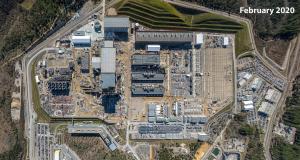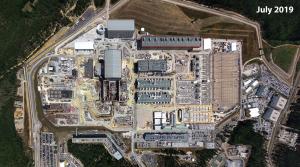Image of the week
More than meets the eye
9 Mar 2020
Eight months separate these two satellite-like images of the ITER site.
In July 2019, nine years into construction, concrete pouring had reached the seventh and final level (L5) in the Tokamak Building but the edifice was still roofless—the first pillar of the steel structure would only be installed in September. Eight months later, the roof is completed, and so is the first layer of cladding on the three sides of the building.
To the left, in the July 2019 image, the cooling cells in the heat rejection zone are still under construction and piping and pumps are not yet installed.
Adjacent to the heat rejection zone, the batching plant is still active, producing the last of the 250,000 cubic metres of concrete that were needed for building construction. Now that 75 percent of civil works to First Plasma is complete, the volume of concrete needed is only a fraction of what it used to be. The batching plant has been dismantled and the production of a local facility in nearby Vinon-sur-Verdon will be sufficient to cover present and future needs.
In terms of worksite progress there is, however, more than just meets the eye: in July 2019, when ITER and its Indian partners celebrated the finalization of both the cryostat base and lower cylinder, the upper cylinder was in the early stages of assembly and welding. Last month, workers were busy cleaning the finalized upper cylinder prior to wrapping it into its protective cocoon.
Assembly preparations are accelerating. In July 2019, the different parts of the upending tool, manufactured in Korea, had not yet taken to the sea. Now, the fully assembled tool is being maneuvered and tested. And in every building, unseen by the peering eye of the drone hovering above the platform, equipment installation is progressing quickly, bringing ITER closer to its first major appointment with history—the production of First Plasma in less than six years.



